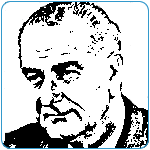 Brazilian Economic Miracle and the Revolution of 1964
Brazilian Economic Miracle and the Revolution of 1964
Case Study
Communism and the Revolution of 1964
The Best of Times
The one-day, bloodless Revolution of 1964 was popular and a great relief.
Millions poured into the streets of Rio de Janeiro and São Paulo in a spontaneous victory celebration on the day of the counter-coup. The threat of communist dictatorship had been lifted.
The military takeover was strongly supported by the United States.
Even the liberal New York Times was pleased, calling Goulart the greatest threat to U.S. interests since the Cuban Revolution.
President Lyndon Johnson (1908-1973), through Secretary of State Dean Rusk (1909-1994), and the U.S. ambassador to Brazil, Lincoln Gordon, let the Brazilian military know that action against Goulart had full U.S. support.
 In the Cold War, Lyndon Johnson could count on America's Brazilian allies to fight communism
In the Cold War, Lyndon Johnson could count on America's Brazilian allies to fight communism For the next fifteen years, the military guided Brazilian economic progress, installed a two party system, and maintained a democratic structure for state, municipal, and legislative elections, while naming a different general as President for each five-year term.
None of the generals became rich. Human rights abuses never approached levels of Argentina or Chile.
Following the revolution, the communists, Marxists, and other radicals were not executed or sent to concentration camps.
Instead, they were simply exiled to other countries where many lay in wait for a chance to return, often financed by the Soviet Union.
The result of the Revolution of 1964 was fifteen years of stable, peaceful, comparatively well-run government that made the 'Brazilian Miracle' possible.
The motivation of the generals in the 1960s was similar to that of the 'tenentes' movement in the 1920s and 1930s — to postpone the turmoil and inefficiency of liberal democracy and to concentrate on economic development for the good of the nation.
Unlike other authoritarian regimes, Brazilian military rule produced no central figure intent on remaining in power
Unlike authoritarian regimes in Argentina, Chile, South Korea, Indonesia, or Singapore, Brazilian military rule from 1964 to 1979 produced no central figure intent on remaining in power.
This had the advantage of making peaceful return to democracy possible (which had always been the intention).
On the other hand, extreme long-term projects, requiring sustained commitment over fifteen to twenty years, such as the reform of primary education, were not undertaken.
Consequently, the Brazilian Miracle consisted of successful five year plans, focusing on the economic infrastructure: industry, transportation, and power, but failing in essential reform of public education — a twenty-year project.
The End of the Miracle
In the late 1970s, with 'Jimmy' Carter as President, the United States turned against its military allies in Brazil, demanding the immediate return of civilian rule.
For an uncompromising assessment of the Carter presidency, see Steven Hayward's 'The Real Jimmy Carter'.
The Brazilian soldiers who had fought along side with Americans in Monte Cassino were now either retired or dead.
The next generation of military leaders did not have the stomach to face the international propaganda machine that the Carter administration and the left had set up against them.
Carter ordered the withdrawal of the U.S. military attache from Brazil, a seemingly trivial measure that had profound effects on the lives of millions of Brazilians over the next decade.
 The feckless 'Jimmy' Carter turned against America's traditional friends in Brazil
The feckless 'Jimmy' Carter turned against America's traditional friends in BrazilRather than gratitude for having patriotically saved Latin America's largest country and one hundred million people from communism and for having engineered an Economic Miracle that brought prosperity and growth of 10% a year, the generals found themselves facing a hostile U.S. president and condemnation from socialist elites that controlled politically correct thought in international academic circles and the media.
By March 1979, with the end of the term of President Ernesto Geisel (1907-1996), the period of economic discipline and civil peace came to an end.
The generals, dispirited with the lack of international understanding for their accomplishments and endeavors, did not struggle to retain power, nor were they forced from office. The military had been reluctant to take control in 1964 and never intended to keep it.
General João Baptista de Oliveira Figueiredo (1918-1999), who became president in 1979, did not attempt to maintain the political discipline essential for continuation of the Economic Miracle.
He immediately undertook the task of returning the country to civilian rule.
Leftists Return in 1979
In August 1979, amnesty was granted to Brazilian communists in exile.
By December 1979, Leonel Brizola was back in the country, taking a whole floor in the Everest Hotel in Ipanema, doling out campaign funds to politicians and left-wing ideologues, eager for power and a chance to exploit the masses.
 With Soviet financing and approval of U.S. liberals, Leonel Brizola returned from exile, bankrupting Rio de Janeiro and ushering in a decade of death squads
With Soviet financing and approval of U.S. liberals, Leonel Brizola returned from exile, bankrupting Rio de Janeiro and ushering in a decade of death squadsBrizola, with funding from the Soviets, became governor of the State of Guanabara and left a legacy that was in sorry contrast to the productive governance of Carlos Lacerda a decade earlier.
By the end of the 1980s, Brazil was bankrupt and in the hands of the IMF.
Annual inflation was running over 1000%, crime had taken control of the cities, and a hundred million Brazilians passed through the 'lost decade' of the 1980s.
'Democracy' had conquered 'Ordem e Progresso'.
In contrast to the competent economic ministers that guided the economy during the period of military rule, by the 1990s, Brazil had a finance minister, Zélia Cardoso de Mello, who confiscated the savings of middle-class Brazilians before being removed from office after a soap-opera sex scandal with the Minister of Justice.
This sad state was largely praised as a 'victory for democracy' by liberals in American universities.
The history of the Brazilian Miracle has now been assiduously rewritten in the best Orwellian fashion.
There is even a commission to seek out victims of the military regime, but after twenty years of searching for lurid examples to match Argentina or Chile, this commission has come up a surprisingly short list of claims, consisting mostly of communists insurgents and terrorists who had explicit goals of killing officials and the bourgeoisie, bombing buildings, kidnapping ambassadors, and robbing banks.
 In 2005, the Brazilian Communist Party is back!
In 2005, the Brazilian Communist Party is back!In contrast to the fifteen years of the Economic Miracle, during the 1980s and 1990s — the years of the 'return of democracy'— thousands of street children have been routinely murdered by death squads that became virulent as a result of criminalization of the Rio de Janeiro police under the venal governor, Leonel Brizola.
Hundreds of ordinary citizens were now kidnapped for ransom.
Armored plating for passenger automobiles was now routinely sold in stores in Copacabana.
By the end of the 1980s, foreign tourists to Rio de Janeiro had to be accompanied by guards armed with submachine guns for protection against the criminals who ruled the streets, even at high noon.
The efficient hydro-electric power grid installed under military rule, a showcase of environmentally-friendly power for the rest of the world, had been dismantled and by 2003, Brazil again faced blackouts and shortages of electricity as it had in the 1950s.
These are some indications of how bad things became after the end of the years of military rule, peace, and the Brazilian Miracle.

